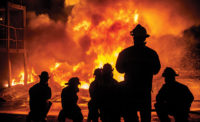- Is the air acceptable for normal, unprotected breathing? and
- Does a potential explosive hazard exist?
Fortunately, a wide variety of gas detection equipment is available for fire service workers. Today's technology can meet almost any detection need, from simple, single toxic or combustible gas detectors to portable analytical laboratories.
However, one flexible, economical product is generally the best choice for both daily use and emergencies. The portable multigas detector is a single unit that can sense several gases at the same time - and a tool that no firefighting crew should be without.
Four types
Portable multigas detectors come in many styles and configurations. In most cases, they can simultaneously detect two to five gases and alert the user when the gas exposure level becomes a concern.These detectors consist of multiple sensors in a single case. Instrument electronics convert the sensor output into a numerical display indicating the level of gas exposure. There are four basic types of portable gas sensors: catalytic, electrochemical, infrared and photoionization. These four sensors operate in different ways, enabling each to detect certain gases.
1) Catalytic - The two most common types of sensors are catalytic and electrochemical. Catalytic combustible gas sensors can detect a wide variety of potentially flammable gases, from natural gas leaks to gasoline spills.
2) Electrochemical - Electrochemical sensors are used to monitor a variety of toxic gases, as well as oxygen levels, to ensure that the atmosphere is not harmful to workers and that they can sustain normal breathing. The two toxic gases most commonly encountered by fire service workers are carbon monoxide (CO) from furnace leaks or car exhaust, and hydrogen sulfide (H2S) from sewer gas.
3) Infrared - Infrared and photoionization sensors are designed to detect either special gases or very low levels of gas that cannot be detected by catalytic or electrochemical technologies. Infrared (IR) sensors measure the amount of light absorbed by a gas to determine its concentration. This is the best portable gas detection method available for monitoring carbon dioxide (CO2), a common byproduct of fermentation processes such as brewing.
4) Photoionization - Photoionization (PID) sensors are used to detect volatile organic compounds (VOCs). This class of typically industrial compounds (which includes toluene and isobutylene) is sometimes present during emergency spill response actions. VOCs can be toxic at relatively low concentrations over the long term, and this has caused significant concerns in industries where worker exposure must be limited.
Portability is key
Though the sensor is the heart of the gas detector, the instrument's portability and operation should be evaluated. Portable multigas detectors range from small handheld instruments to larger units that may be placed on the ground. Since emergency response teams generally carry a large quantity of gear, smaller instruments are most practical.
First and foremost, an instrument must be able to rapidly assess gas readings in emergency situations. It should have such physical features as an easily seen display and alarm lights. In addition, it should be simple to operate and maintain. Even the smallest instruments employ sophisticated software. Before purchasing a unit, be sure to perform a trial-run and familiarize yourself with its operation.
Be prepared
Multigas detectors are used in a variety of applications in the fire service, including:
A multigas detector can help determine if the premises are safe. In addition, they often provide the leak detection necessary to locate the source of the problem. Workers may also be called in for natural gas leaks or "bad smells." Having the capability to measure several gases at once becomes a distinct advantage in these situations.
Meeting the need
From standard catalytic and electrochemical sensors to advanced IR and PID sensors, multigas detectors are well suited to meet the needs of emergency response personnel. They detect a wide variety of gases and vapors that threaten the safety of response teams.
A standard four-gas unit with combustible, oxygen, carbon monoxide and hydrogen sulfide sensors is generally adequate for most needs. These devices can help ensure that everyone goes home safely at the end of their shift. Gas detection is fundamental to emergency response.
SIDEBAR: Calibration - Make it a habit
Sensor maintenance is a necessary part of proper gas detection. While most digital instruments are equipped with electronic self-diagnostics, sensors must still be checked directly.It is usually obvious when an oxygen sensor is inoperative since it should read near 20.8 percent under normal circumstances. If it's malfunctioning, it will likely be unable to read properly in clean ambient air.
Other sensors, however, typically have no output - the instrument display will read "zero." To verify proper operation, you should institute a program in which each gas sensor is exposed to a known level of gas before each day's use. Without this calibration check, you could falsely assume the atmosphere is safe when it actually contains deadly gases. You don't have to fully readjust your instruments each day, but you must be certain they are operating within the manufacturer's specified limits.
